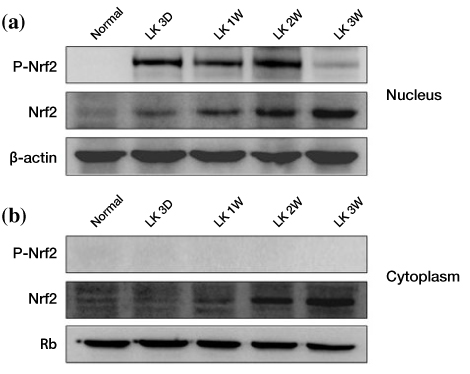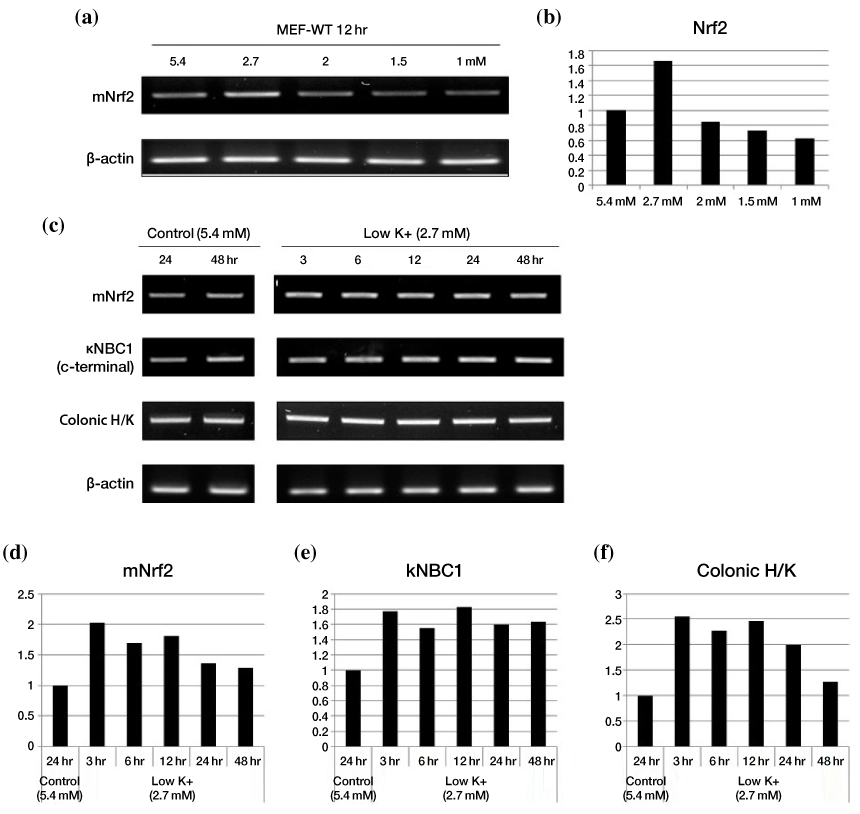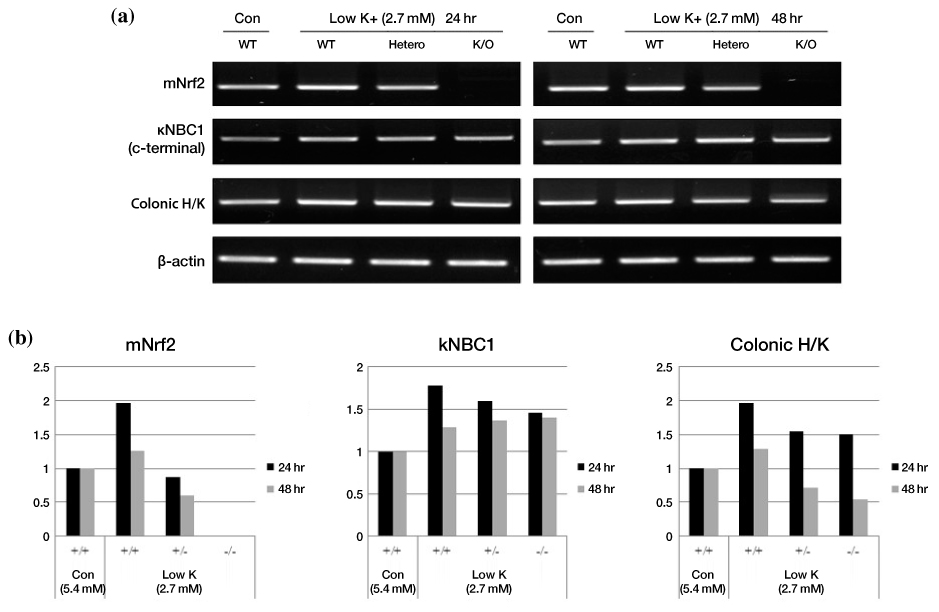Anat Biol Anthropol.
2019 Dec;32(4):141-149. 10.11637/aba.2019.32.4.141.
Regulatory Pathway of Ion-Transporter Genes through Nrf2 Transcription Factor in Hypokalemic Condition
- Affiliations
-
- 1Department of Anatomy, Chonnam National University Medical School, Korea. kyahn@jnu.ac.kr
- KMID: 2467467
- DOI: http://doi.org/10.11637/aba.2019.32.4.141
Abstract
- The Nuclear factor-erythroid-2-related factor 2 (Nrf2) plays a key role in the cellular defense against oxidative stress. Low K+ increased the reactive oxygen species and it stimulate Nrf2 activation. Previous our study demonstrated that low potassium promoted expression of H/K-ATPase and kNBC1 by Nrf2 transcription factor in cultured models. In addition, phosphorylation of ERK, JNK, p38 and PI3K was involved in the activation of Nrf2 expression. This study aims to elucidate the mechanism which low potassium regulates Nrf2 expression through various in vitro and in vivo models. Using various kinase inhibitors, promotion of Nrf2 expression in low potassium condition was inhibited by LY294002 and SP600125 while PD98059 and SB203580 did not affect Nrf2, suggesting that phosphorylation of Akt and JNK is specifically involved in Nrf2 expression in low potassium condition. Kidney tissues from low potassium diet rats showed increased phospho-ERK1/2 and phospho-Akt in diet time dependent manner but no effect to JNK and p38 phosphorylation. Specifically, Phospho-Nrf2 was also increased in nuclear compartment by low potassium diet. In order to demonstrate direct evidence that low potassium regulates ionic transporters by Nrf2, Nrf2 knockout mice were employed. Mouse embryonic fibroblasts (MEF) were harvested for the study. As expected, low potassium promotes expression of Nrf2 and level of phospho-ERK1/2 and phospho-Akt in MEF-Nrf2 (+/+). Low potassium promoted expression of kNBC1 and H/K-ATPase in MEF-Nrf2 (+/+), but unchanged or even decreased in MEF-Nrf2 (+/−) and MEF-Nrf2 (−/−). Taken together, these results show that Nrf2 was activated by ERK1/2 and AKT in low potassium condition and further regulates expression of kNBC1 and colonic H/K-ATPase.
Keyword
MeSH Terms
Figure
Reference
-
1. Giebisch G. Renal potassium transport: mechanisms and regulation. Am J Physiol. 1998; 274:F817–F833.
Article2. Bae CS, Cho HJ, Ahn KY. Alteration of Akt, p-AKT, ERK, and p-ERK proteins expression in the kidney of hypokalemic rat. Korean J Phys Anthropol. 2017; 30:87–98. Korean.
Article3. Ahn KY, Turner PB, Madsen KM, Kone BC. Effect of chronic hypokalemia on renal expression of the gene encoding the “gastric” H(+)-K(+)-ATPase alpha-subunit. Am J Physiol. 1996; 270:F557–F566.4. Ahn KY, Park KW, Kim KK, Kone BC. Chronic hypokalemia enhances expression of the H(+)-K(+)-ATPase α2 alpha 2-subunit gene in renal medulla. Am J Physiol. 1996; 271:F314–F321.5. Ahn KY, Kim SC, Moon B, Kim KK, Kim BY. Renal adaptive responses of Na+-K+-ATPase subunit isoforms to chronic hypokalemia. Korean J Anat. 1998; 31:405–418. Korean.6. Kim JH, Cho HJ, Bae MO, Park JJ, Ahn KY. Regulation of biocarbonate ions hypokalemic rat kidney. Korean J Anat. 2004; 37:337–345. Korean.7. Lim JS, Ahn KY. Expression of Nrf2 transcription factor in rat kidney. Korean J Nephrol. 2011; 30:239–245. Korean.8. Lee CB, Lee YS, Lee JY, Lee SE, Ahn KY. Nrf2 and Sp synergistically enhance the expression of ion transporters in potassium-depleted conditions. J Nephrol. 2012; 25:225–232.
Article9. Moi P, Chan K, Asunis I, Cao A, Kan YW. Isolation of NF-E2-related factor 2 (Nrf2), a NF-E2-like basic leucine zipper transcriptional activator that binds to the tandem NF-E2/AP1 repeat of the beta-globin locus control region. Proc Natl Acad Sci U S A. 1994; 91:9926–9930.
Article10. Itoh K, Igarashi K, Hayashi N, Nishizawa M, Yamamoto M. Cloning and characterization of a novel erythroid cell-derived CNC family transcription factor heterodimerizing with the small Maf family proteins. Mol Cell Biol. 1995; 15:4184–4193.
Article11. Liu M, Grigoryev DN, Crow MT, Haas M, Yamamoto M, Reddy SP, et al. Transcription factor Nrf2 is protective during ischemic and nephrotoxic acute kidney injury in mice. Kidney Int. 2009; 76:277–285.
Article12. Yu R, Chen C, Mo YY, Hebbar V, Owuor ED, Tan TH, et al. Activation of mitogen-activated protein kinase pathways induces antioxidant response element-mediated gene expression via a Nrf2-dependent mechanism. J Biol Chem. 2000; 275:39907–39913.
Article13. Motohashi H, Yamamoto M. Nrf2-Keap1 defines a physiologically important stress response mechanism. Trends Mol Med. 2004; 10:549–557.
Article14. Shen G, Jeong WS, Hu R, Kong AN. Regulation of Nrf2, NF-kappaB, and AP-1 signaling pathways by chemopreventive agents. Antioxid Redox Signal. 2005; 7:1648–1663.
Article15. Cho HJ, Ahn KY. Alteration of Nrf2 and p-Nrf2 proteins expression in hypokalemic rat kidney. Korean J Phys Anthropol. 2015; 28:55–62. Korean.
Article16. Zhou X, Yin W, Doi SQ, Robinson SW, Takeyasu K, Fan X. Stimulation of Na, K-ATPase by low potassium requires reactive oxygen species. Am J Physiol Cell Physiol. 2003; 285:C319–C326.17. Babilonia E, Wei Y, Sterling H, Kaminski P, Wolin M, Wang WH. Superoxide anions are involved in mediating the effect of low K intake on c-Src expression and renal K secretion in the cortical collecting duct. J Biol Chem. 2005; 280:10790–10796.
Article18. Deplancke B, Gaskins HR. Redox control of the transsulfuration and glutathione biosynthesis pathways. Curr Opin Clin Nutr Metab Care. 2002; 5:85–92.
Article19. Kwon T, Kwon DY, Chun J, Kim JH, Kang SS. Akt protein kinase inhibits Rac1-GTP binding through phosphorylation at serine 71 of Rac1. J Biol Chem. 2000; 275:423–428.
Article20. Vivanco I, Sawyers CL. The phosphatidylinositol 3-kinase AKT pathway in human cancer. Nat Rev Cancer. 2002; 2:489–501.
Article21. Osaki M, Oshimura M, Ito H. PI3K-Akt pathway: its functions and alterations in human cancer. Apoptosis. 2004; 9:667–676.
Article22. Jaiswal AK. Nrf2 signaling in coordinated activation of antioxidant gene expression. Free Radic Biol Med. 2004; 36:1199–1207.
Article
- Full Text Links
- Actions
-
Cited
- CITED
-
- Close
- Share
- Similar articles
-
- Alteration of Nrf2 and p-Nrf2 Protein Expression in Hypokalemic Rat Kidney
- Potassium Depletion Upregulates Expression of Nrf2 Transcription Factor in Rat Kidney
- Kelch-like ECH-associated Protein 1/Nuclear Factor Erythroid 2-related Factor 2 Pathway and Its Interplay with Oncogenes in Lung Tumorigenesis
- Alteration of Akt, p-Akt, ERK, and p-ERK Proteins Expression in the Kidney of Hypokalemic Rat
- Dysregulation of NRF2 in Cancer: from Molecular Mechanisms to Therapeutic Opportunities






